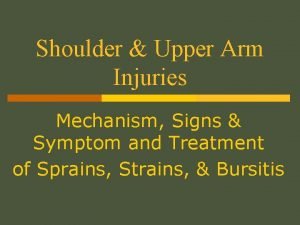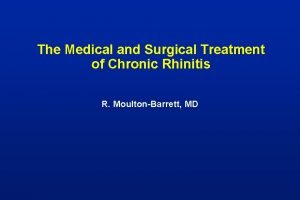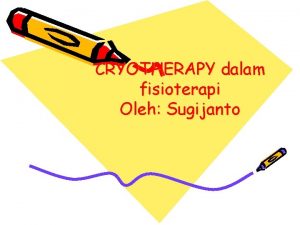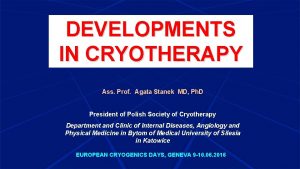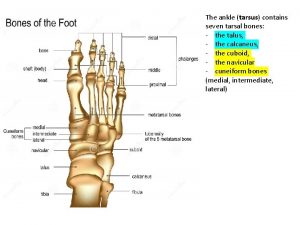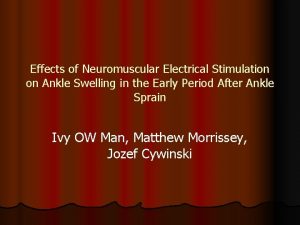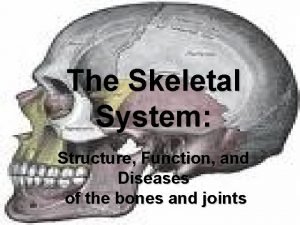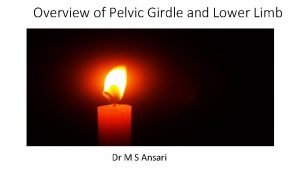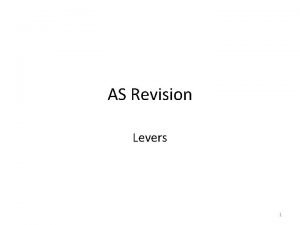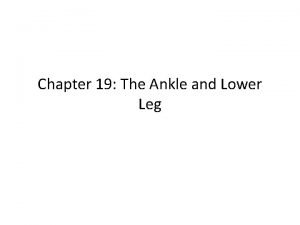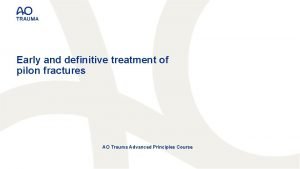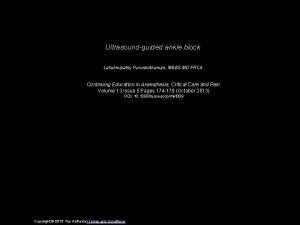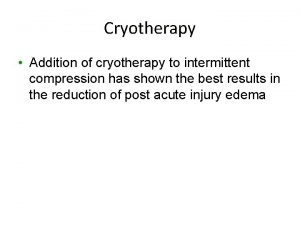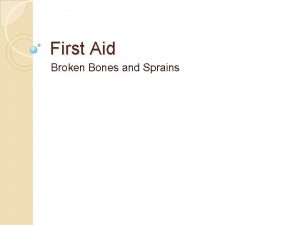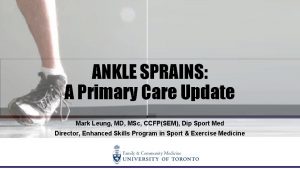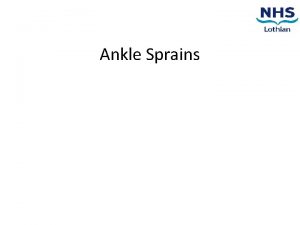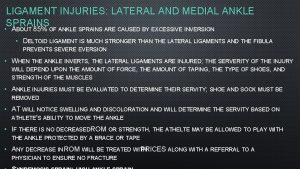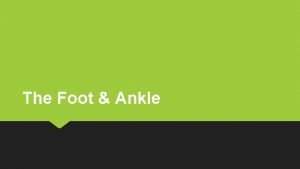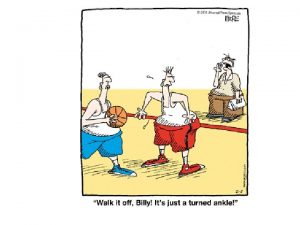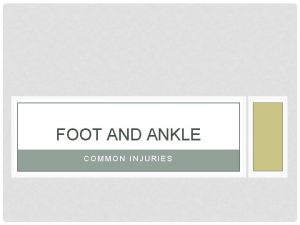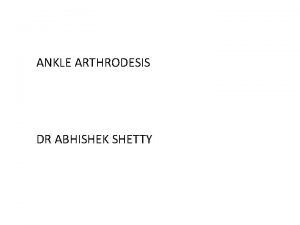Cryotherapy Techniques Applied to Acute Ankle Sprains Tyler















- Slides: 15

Cryotherapy Techniques Applied to Acute Ankle Sprains Tyler Beauchamp

Definitions § Cry/o/therapy – “cry” meaning cold § ROM – range of motion § MMT – manual muscle testing § RTP – return to play § Edema – swelling § Inversion – foot rolls in § Eversion – foot rolls out § Dorsiflexion – toes to the nose § Plantarflexion – foot to the floor

Introduction § Cryotherapy is used for rehabilitation purposes to decrease swelling and increase ROM § Used to block nerve fibers from moving from the injured site to the thalamus § Used in the inflammatory response phase of the healing process

http: //www. aafp. org/afp/2001/0515/p 1979. htm

http: //www. arjohuntleigh. com/Page. asp? Page. Number=3

Cryotherapy Methods

Cryotherapy for acute ankle sprains: a randomised controlled study of two different icing protocols § Ice pack (compression) vs intermittent § Purpose: to compare intermittent cryotherapy to a standard cryotherapy treatment § Participants: 89 subjects with mild or moderate ankle sprains within the past 48 hours (16+ years old) § Method: subjects randomly assigned into two groups; standard ice application or intermittent ice application § Results: no significant difference between the two groups for ankle function or swelling § Intermittent reduced the level of subjective pain during activity compared to the standard application

Comparison of Three Treatment Procedures for Minimizing Ankle Sprain Swelling § Purpose: to compare the effects of cold, heat, and contrast bath on swelling in subjects with acute ankle sprains § Participants: 30 students (18 -22 years old) with an acute ankle sprain § Method: randomly assigned to one of three treatment groups; cold whirlpool, warm whirlpool, or contrast bath § Results: cold therapy showed a significant difference in reduction of swelling § Warm whirlpool and contrast bath showed no significant difference in reducing swelling

Problem § There is no declarative research that has provided information to determine which method is most effective § Each method of cryotherapy has been observed in research on its effectiveness but most have not been compared to another method § Studies using cryocuff or biocryo are scarce § Both applications utilize the same methods that both ice packs and cold whirlpools have

Purpose § To compare and determine the most effective method for increasing ROM and decreasing edema in male collegiate level basketball players during season § Cryocuff and biocryo applications will be compared in order to determine effectiveness

Importance § It is important to reach a declarative conclusion and understand how each method works in a specific situation § Having evidence would help collegiate programs select the appropriate treatment method for an athlete to RTP quicker § Decreasing edema allows for further treatment and strengthening to take place

Procedures § 30 male collegiate basketball players suffering from an acute ankle injury (18 – 24 years) § Subjects randomly divided into two different groups; cryocuff and biocryo treatment groups § Each participant will partake in therapeutic exercise to further strengthen the ankle § Those with +3 recurrent ankle sprains will be excluded § Pre-test / post-test method

Goniometer Theraband

Expected Results Hypotheses: § Application of the biocryo regimen will prove to be more beneficial in decreasing edema rather than the cryocuff treatment § Application of the biocryo regimen will prove to have more of a significant impact on increasing ROM rather than the cryocuff treatment

References § Bleckley, C. M. , Mc. Donough, S. M. , & Mac. Auley, D. (2006). Cryotherapy for acute ankle sprains: a randomised controlled study of two different icing protocols. British Journal of Sports Medicine, 40(8), p 700 -706. Retrieved February 17, 2013, from the SPORTDiscus database. § Cote, D. J. , Prentice, W. E. , Hooker, D. N. , & Shields, E. W. (1988). Comparison of Three Treatment Procedures for Minimizing Ankle Sprain Swelling. Journal of the American Physical Therapy Association, 68, 1072 -1076. Retrieved March 3, 2013, from the Pub. Med database. § Denegar, C. R. , Saliba, E. , & Saliba, S. F. (2006). Therapeutic modalities for musculoskeletal injuries (3 rd ed. ). Champaign, IL: Human Kinetics. § Hislop, H. J. , & Montgomery, J. (2007). Daniels and Worthingham's muscle testing: techniques of manual examination. (8 th ed. ). St. Louis, Mo. : Saunders / Elsevier. § Norkin, C. C. , & White, D. J. (2009). Measurement of joint motion: a guide to goniometry (4 th ed. ). Philadelphia: F. A. Davis. § Shultz, S. J. , Houglum, P. A. , & Perrin, D. H. (2005). Examination of musculoskeletal injuries (2 nd ed. ). Champaign, IL: Human Kinetics. § Starkey, C. , Brown, S. D. , & Ryan, J. L. (2010). Examination of orthopedic and athletic injuries (Ed. 3. ed. ). Philadelphia: F. A. Davis Co. .
 Sprains and strains
Sprains and strains Vidian nerve cryotherapy
Vidian nerve cryotherapy Cryotherapy fisioterapi
Cryotherapy fisioterapi Cryotherapy for cellulite before and after
Cryotherapy for cellulite before and after Fonctions techniques
Fonctions techniques Articulatio talo tarsalis
Articulatio talo tarsalis Electronic muscle stimulation ankle sprain
Electronic muscle stimulation ankle sprain Ankle injection
Ankle injection Ankle invertors
Ankle invertors Twisted ankle
Twisted ankle Ankle jerk
Ankle jerk Advantages and disadvantages of first class levers
Advantages and disadvantages of first class levers Chapter 19 worksheet the ankle and lower leg
Chapter 19 worksheet the ankle and lower leg Ankle eversion
Ankle eversion Chaput fragment ankle
Chaput fragment ankle Ankle block frca
Ankle block frca
